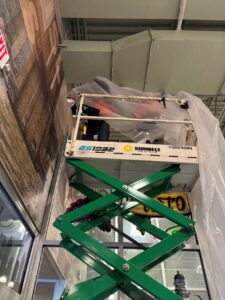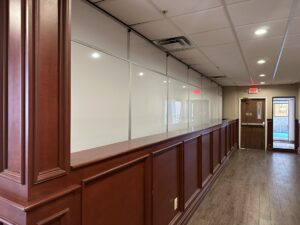The Role of Temporary Modular Wall Systems in Eco-Friendly Construction
As part of the global effort to reduce carbon emissions, the construction industry is well-poised to have a significant environmental impact in the coming years. After all, there’s plenty of opportunity — McKinsey reported in 2021 that “construction is responsible, directly or indirectly, for almost 40 percent of global CO2 emissions … and 25 percent greenhouse gas emissions overall.”
In spite of its track record, the building and construction industry is undergoing an undeniable transformation: In the same report above, McKinsey shared that in a recent poll of construction businesses, more than 85 percent of respondents said their organizations are now committed to rooting their company culture and business model in sustainability.
With the rise of sustainability as a central theme in modern construction, green building and construction practices are growing in popularity every day. Against this backdrop, modular wall systems are emerging as an environmentally responsible solution for temporary construction walls. In this article, we’ll explore the various ways they contribute to eco-friendly building.
1. They’re reusable
Modular wall systems stand out for their reusability, a fundamental aspect of sustainability. According to the EPA (United States Environmental Protection Agency), some of the benefits of reducing and reusing include:
- Reducing greenhouse gas emissions that contribute to climate change
- Reducing pollution by reducing the harvesting of new raw materials
- Saving on energy
- Reducing waste that will need to be recycled or sent to landfills and incinerators
Temporary modular wall systems are designed to be easily assembled, disassembled, and repurposed. Unlike traditional construction barriers, which often end up as waste in landfills, modular wall panels can be reused numerous times without compromising their structural integrity.
For instance, a construction company utilizing modular walls for an office renovation can later repurpose these panels for a different construction or remodeling project at another site. This reusability dramatically reduces the need for new materials, promoting a circular economy and minimizing waste.
2. They can be adapted easily for most building environments
Modular wall systems are designed to be adaptable and flexible. This versatility allows builders to reuse them in a variety of configurations and layouts. As a single construction project evolves, modular wall panels can be rearranged, added to, or removed in order to fit new spatial requirements. Alternatively, this adaptability ensures that the same set of modular panels can be repurposed for different projects on other sites.
For example, a company using modular wall systems as a temporary construction barrier in a shopping mall for one project can later reconfigure and repurpose these walls for any number of construction projects, whether at a healthcare facility or even school or university. Such flexibility extends both the usefulness and lifespan of a modular wall system.
3. They replace environmentally damaging materials
Another sustainable aspect of modular wall systems is their role in replacing traditional temporary construction walls that can be damaging to the environment. For instance, compared to drywall, which is commonly used in construction for not just permanent but temporary walls, modular wall systems often require fewer raw materials and resources for their production.
Not only that, drywall manufacturing involves gypsum mining, a process that can lead to:
- Habitat destruction and loss of biodiversity
- Soil erosion and degradation
- Disruption of hydrological systems, impacting water flow patterns and potentially drying up water sources
- Contamination of ecosystems, groundwater, and bodies of water
Drywall makes up about 15 percent of construction and demolition debris. Once discarded in landfills, it releases harmful chemicals into groundwater and emits poisonous hydrogen sulfide gas into the atmosphere.
In contrast, modular wall systems can be made using recycled materials or materials that have a lower impact on the environment.
4. They reduce construction time
Modular wall systems are designed for efficient installation and disassembly, which translates to reduced construction time. This in turn means more sustainable projects.
Time efficiency in construction can be a significant factor impacting sustainability for several reasons:
- Swift construction processes result in resource optimization by reducing the time it takes to consume resources such as energy, water, and materials.
- Faster construction means lower energy consumption, especially when projects involve heavy machinery or energy-intensive processes.
- The shorter a construction project, the less disruption to ecosystems there will be. This is especially important in ecologically rich, biodiverse, or otherwise environmentally sensitive areas.
- The sooner a green building facility is completed and open for use, the sooner the occupants — and the community at large — can enjoy the implementation of sustainable building features.
- Shortening the duration of construction activities can result in reduced environmental impact by decreasing energy consumption, emissions, and resource usage as well as minimizing disturbances to the local ecosystem caused by noise pollution and habit disruption.
- The less time it takes to complete a project, the higher the cost savings. This means more funds will be available to invest in sustainability initiatives.
Traditional construction barriers, such as temporary drywall, are often more time-intensive than modular wall systems. For example, installing drywall requires extra time for the curing and drying processes involved, and deinstallation involves additional steps for demolition and waste removal.
In contrast, temporary modular wall systems can be rapidly assembled and disassembled, streamlining construction timelines and contributing to overall reduced environmental impact.
5. They lower the industry’s carbon footprint
Finally, there’s the collective impact of the points above on the carbon footprint of the building and construction industry as a whole.
Thanks to lower waste generation, increased efficiency, reusability, and reduced construction time, modular wall systems stand at the forefront of sustainability building practices that contribute to the reduction of carbon footprints in construction activities.
When utilized by builders striving for carbon neutrality, such approaches align with the overarching goal of reducing not just carbon but other greenhouse gas emissions to net zero, which will be a pivotal milestone in the fight against climate change.
Temporary modular wall systems for a greener future
According to the Office of the Federal Chief Sustainability Officer, “All new construction and major modernization projects larger than 25,000 GSF [gross square feet] entering the planning stage will be designed, constructed, and operated to be net-zero emissions by 2030, and where feasible, net-zero water and waste.” This is indeed a tall order, and it entails prioritizing a number of green building practices.
In recent years, temporary modular wall systems have emerged as a leading sustainable building construction method thanks to their reusability, adaptability, and other environmentally friendly characteristics. As the world increasingly emphasizes sustainable and responsible construction, the utilization of modular wall systems as temporary construction barriers is expected to grow, contributing to a greener future not only in the construction sector but for the planet as a whole.
At Temporary Wall Systems, we’re dedicated to ensuring your projects, no matter the size, are safe, clean, and environmentally responsible. Learn more about our temporary wall systems.


